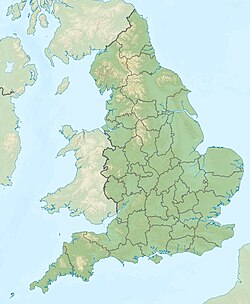Beacon Limestone Formation Geological formation in England
The Beacon Limestone Formation , historically known as the Junction Bed , is a formation of the early Jurassic age (Pliensbachian –Toarcian ). It lies above the Dyrham Formation and below the Bridport Sand Formation . It forms part of the Lias Group . It is found within the Wessex Basin and parts of Somerset ,[ 1] England . It is well known for the Strawberry Bank Lagerstätte, which contains the 3-dimensionally preserved remains of vertebrates, including marine crocodyliformes, ichthyosaurs and fish, as well as insect compression fossils.[ 2]
Fossil content
Among others, the following fossils have been reported from the formation:
Vertebrates
Vertebrates of the Beacon Limestone
Genus
Species
Location
Stratigraphic position
Abundance
Notes
Images
Hauffiopteryx H. typicus
Strawberry Bank
Falciferum zone
Lectotype: GPIT 1491/4, referred: BRLSI M1399, BRLSI M1400,
BRLSI M1401, BRLSI M1403, BRLSI M1404 and BRLSI M1406[ 3]
Ichthyosaur subsequently suggested to belong to Leptonectes [ 4]
Stenopterygius S. triscissus
Holotype: GPIT 12/0224-2 referred: BRLSI M1405, BRLSI M1407, BRLSI M1408 and BRLSI M1409[ 3]
Ichthyosaur
Pelagosaurus P. typus
"four isolated skulls and associated postcranial skeletal elements along with two articulated specimens, one of which is a small juvenile"[ 5]
Thalattosuchian
Pachycormus P. macropterus
BRLSI M1297, BRLSI M1299, BRLSI M1320, BRLSI M1332, BRLSI M1359, BRLSI M1389, BRLSI M1395, BRLSI M1341, BRLSI M1351, BRLSI M1366, BRLSI M1393[ 6]
Pachycormiform fish
Leptolepis Indeterminate
BRLSI M1259 complete specimen.[ 2]
4–8 cm (1.6–3.1 in) in length
GB3D
Lepidotes Indeterminate
40–45 cm (16–18 in) in length
Caturus Indeterminate
"two specimens, including an isolated neurocranium (BRLSI M1288)"[ 2]
Amiiform fish
BRLSI
Invertebrates
References
^ "Beacon Limestone Formation" . BGS Lexicon of Named Rock Units . Retrieved 8 March 2018 .^ a b c Williams, Matt; Benton, Michael J.; Ross, Andrew (November 2015). "The Strawberry Bank Lagerstätte reveals insights into Early Jurassic life" . Journal of the Geological Society . 172 (6): 683– 692. Bibcode :2015JGSoc.172..683W . doi :10.1144/jgs2014-144 . hdl :1983/a7fc8bb4-889c-4fe9-b049-86d284141316 ISSN 0016-7649 . S2CID 52971056 . ^ a b Caine, Hannah; Benton, Michael J. (September 2011). "Ichthyosauria from the Upper Lias of Strawberry Bank, England". Palaeontology . 54 (5): 1069– 1093. Bibcode :2011Palgy..54.1069C . doi :10.1111/j.1475-4983.2011.01093.x . ^ Marek, Ryan D.; Moon, Benjamin C.; Williams, Matt; Benton, Michael J. (15 June 2015). "The skull and endocranium of a Lower Jurassic ichthyosaur based on digital reconstructions" . Palaeontology . 58 (4): 723– 742. Bibcode :2015Palgy..58..723M . doi :10.1111/pala.12174 ISSN 0031-0239 . S2CID 131581009 . ^ Pierce, Stephanie E.; Benton, Michael J. (11 September 2006). "Pelagosaurus typus Bronn, 1841 (Mesoeucrocodylia: Thalattosuchia) from the Upper Lias (Toarcian, Lower Jurassic) of Somerset, England" (PDF) . Journal of Vertebrate Paleontology . 26 (3): 621– 635. doi :10.1671/0272-4634(2006)26[621:PTBMTF]2.0.CO;2 . ISSN 0272-4634 . S2CID 131524957 . ^ Cawley, John J.; Kriwet, Jürgen; Klug, Stefanie; Benton, Michael J. (20 September 2018). "The stem group teleost Pachycormus (Pachycormiformes: Pachycormidae) from the Upper Lias (Lower Jurassic) of Strawberry Bank, UK" . PalZ . 93 (2): 285– 302. doi :10.1007/s12542-018-0431-7 hdl :1983/1a98e5d7-53a8-4f69-b1cd-64c284303128 ISSN 0031-0220 . ^ Kelly, Richard S.; Ross, Andrew J.; Jarzembowski, Edmund A. (June 2016). "Earwigs (Dermaptera) from the Mesozoic of England and Australia, described from isolated tegmina, including the first species to be named from the Triassic" . Earth and Environmental Science Transactions of the Royal Society of Edinburgh . 107 (2– 3): 129– 143. Bibcode :2016EESTR.107..129K . doi :10.1017/s1755691017000329 hdl :1983/d363e702-e4cb-4285-8ee8-393e808c890e ISSN 1755-6910 . ^ Kelly, Richard S.; Ross, Andrew J.; Coram, Robert A. (2018). "A Review of Necrotauliids from the Triassic/Jurassic of England (Trichoptera: Necrotauliidae)" . Psyche: A Journal of Entomology . 2018 : 1– 12. doi :10.1155/2018/6706120 hdl :1983/06ae01fb-06bc-41d0-bcbd-f7519cb07df6 ISSN 0033-2615 .

